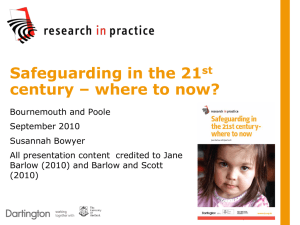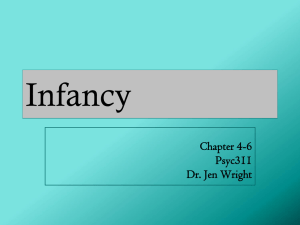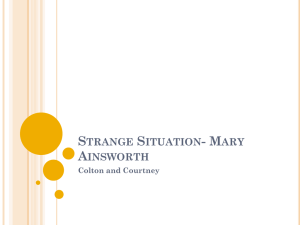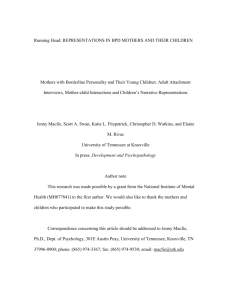Angus MacBeth - Scottish Personality Disorder Network
advertisement
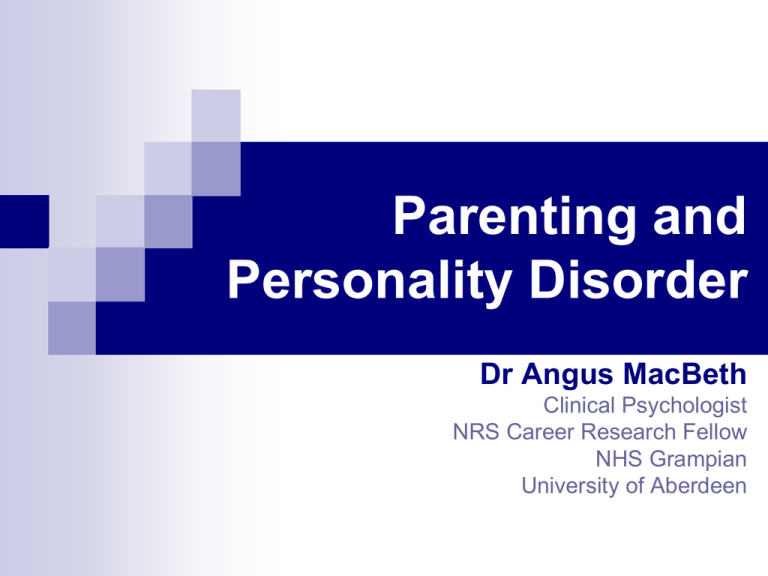
Parenting and Personality Disorder Dr Angus MacBeth Clinical Psychologist NRS Career Research Fellow NHS Grampian University of Aberdeen Acknowledgements Phil Wilson, Lucy Thompson, John Norrie - University of Aberdeen. Jane White, Andrea Williamson, Helen Minnis – University of Glasgow. Marion Henderson, Danny Wight - MRC/CSO SPHSU. Linda Treliving – NHS Grampian. Andrea Williams - NHS Greater Glasgow and Clyde. Community midwives from NHS Ayrshire & Arran & NHS Greater Glasgow & Clyde. Rosemary Mackenzie, Christine Puckering, Harriet Waugh and the Mellow Parenting team. Scottish Collaboration for Public Health Research and Policy. National Scientific Council on the Developing Child (2007). The Timing and Quality of Early Experiences Combine to Shape Brain Architecture: Working Paper #5. http://www.developingchild.net Early experience affects outcome Adverse Childhood Experiences (ACEs) Study Dose effect response linking ACEs to: Adult recall of childhood event Cardiovascular disease Chronic lung disease Cancer Depression Alcoholism Drug abuse ACEs associated with greater life time risk of Life threatening psychiatric disorders Overlapping mental health problems Teen pregnancy Obesity Physical inactivity Smoking Fellitti et al. (1998) Am J Prev Med; Edwards et al. (2003) Am J Psych; Anda et al 2006; Eur Arch Psych Clin Neurosci; Hillis et al. (2004) Pediatrics; Fellitti et al. (2004) Circulation. UNICEF Domains of Child wellbeing Material deprivation Health and Safety family structure, peer relationships Behaviours and Risks School achievement, post-15 education Relationships Infant mortality, immunisations Educational wellbeing Relative income, households without jobs health behaviours, experience of violence Subjective Well-being self-assessed indicators Early experience affects outcome: Dunedin Longitudinal cohort Socially isolated children at significant risk of poor adult health compared with non-isolated children. Association independent of other childhood risk factors for poor adult health (low childhood socioeconomic status, low childhood IQ, childhood overweight). Not accounted for by health-damaging behaviors (lack of exercise, smoking, alcohol misuse). Not attributable to greater exposure to stressful life events. Socially isolated children 20 years later: Risk of cardiovascular disease. Caspi A, Harrington H, Moffitt TE, Milne BJ, and Poulton R 2006 Archives of Pediatrics & Adolescent Medicine 160:805-811. Dunedin Longitudinal cohort Socially isolated children 20 years later: Risk of cardiovascular disease. Caspi A, Harrington H, Moffitt TE, Milne BJ, and Poulton R 2006 Archives of Pediatrics & Adolescent Medicine 160:805-811. National Scientific Council on the Developing Child (2007). The Timing and Quality of Early Experiences Combine to Shape Brain Architecture: Working Paper #5. http://www.developingchild.net Evidence for intergenerational transmission Family association studies report 4-20 fold increase in BPD prevalence in relatives Heterogeneity Familial aggregation of BPD core features Affective instability Impulsivity Bidirectional relationships? Distel et al., (2007). Heritability of borderline personality disorder features is similar across three countries. Psychological Medicine, 38, 1219–29; Silverman et al. (1991). (1991). Affective and impulsive personality disorder traits in the relatives of patients with borderline personality disorder. American Journal of Psychi atry, 148, 1378–1385. Parenting and Personality Disorder Evidence for parenting difficulties for parents with PD? Evidence for effective parenting interventions for parents with PD and their children? What evidence…? Parenting in BPD – Infant data ‘Still face’ experiment n=8 mothers with BPD n=12 mothers with no psychiatric disorder 2-month-old infants Crandell, L. E., Patrick, M. P. H., & Hobson, R. P. (2003). “Still-face” interactions between motherswith borderline personality disorder and their 2-month-old infants. British Journal of Psychiatry, 183, 239–247. Infant still face paradigm Parenting in BPD – Infant data ‘Still face’ experiment n=8 mothers with BPD n=12 mothers with no psychiatric disorder 2-month-old infants Infants from BPD group vs. control infants more dazed looks more gaze aversion less overall responsiveness towards mother Crandell, L. E., Patrick, M. P. H., & Hobson, R. P. (2003). “Still-face” interactions between motherswith borderline personality disorder and their 2-month-old infants. British Journal of Psychiatry, 183, 239–247. Parenting in BPD – Infant data Same sample, infants now 12 months Strange Situation Test 80% of infants in BPD group classified as disorganised attachment 27% of infants in control group classified “D” Limited by small sample size Hobson, P. R., Patrick, M. Crandell, L., Garcıa- Perez, R., & Lee, A. (2005). Personal relatedness and attachment in infants of mothers with border- line personality disorder. Development and Psychopathology, 17, 329–347. Early Childhood data Story stem completion task (children of BPD vs control) BPD group increased likelihood vs controls to: Talk about fantasies as well as material of a traumatic nature. Role reversal Greater fears of abandonment Negative parent– child relationship expectations Relationships characterized by danger and/or unpredictability Incongruent representation e.g., child tells fighting parents to: “Stop that! Go to your room!” (e.g., child cleans his or her room then ruins it Shameful self- representations e.g. the child says he or she is bad Macfie, J., Fitzpatrick, K. L., Rivas, E. M., & Cox, M. J. (2008). Independent influences upon mother- toddler role reversal: Infantmother attachment disorganization and role reversal in mother’s child- hood. Attachment & Human Development, 10, 29 – 39. Parenting in BPD – adolescent/adulthood outcomes School-aged and adolescent children of BPD diagnosed mothers with are at risk for both internalizing and externalizing problems (Feldman et al., 1995; Abela et al., 1996; Barnow et al., 2006). Cognitive and interpersonal vulnerabilities Negative attributional style Ruminative response style Dysfunctional attitudes Self-criticism Insecure attachment style Excessive reassurance seeking. Children in the Community (CIC) Study Children in the Community (CIC) Study Transmission Mechanisms GxE Interactions GxE interaction effects Some children,for temperamental/genetic reasons are more susceptible to: Adverse effects of unsupportive parenting Beneficial effects of supportive parenting Only highly distressed/irritable 4-month- old boys who experienced coercive and rejecting mothering continued to show evidence at 9 months of of emotional and behavioural dysregulation (Murray & Morell, 2003). Males, longitudinally followed from early childhood most likely to manifest high levels of antisocial behavior when they had both a history of child maltreatment and a particular variant of the MAO-A gene (Caspi & Moffitt, 2006). Belsky, J., Bakermans-Kranenburg, M.J., & Van IJzendoorn, M.H. (2007). For better and for worse: Differential susceptibility to environmental influences. Current Directions in Psychological Science, 16, 300-304. Genetic vulnerability/Differential Susceptibility Bakermans-Kranenburg, M.J. & Van IJzendoorn, M.H. (2007). Genetic vulnerability or differential susceptibility in child development: The case of attachment. Journal of Child Psychology and Psychiatry, 48 (12), 1160-1173. Evidence for differential susceptibility Children with reactive or fearful temperament appear to suffer most from persistent family conflict or low quality of day care but also appear benefit disproportionately from supportive environments. Children w/ DRD4 7-repeat allele & unresponsive mothers displayed more externalizing behavior problems than children without the DRD4 7-repeat variant …but children with the DRD4 7-repeat allele and responsive mothers showed the lowest levels of externalizing problem behavior. Bakermans-Kranenburg, M.J., & Van IJzendoorn, M.H. (2011). Differential susceptibility to rearing environment depending on dopamine-related genes: New evidence and a meta-analysis. Development and Psychopathology, 23, 39-52. doi:10.1017/S095457941000063 Environmental Instability Children (aged 4–18) of BPD mothers more likely to be exposed to environmental instability Frequent changes in housing and schooling Removal from the home Maternal suicide attempts. Feldman, R. B., Zelkowitz, P., Weiss, M., Vogel, J., Heyman, M., & Paris, J. (1995). A comparison of the families of mothers with borderline and non- borderline personality disorders. Comprehensive Psychology, 26, 157–163. Transmission Mechanisms GxE Interactions Attachment Attachment Disorganization Infant Disorganized/Disoriented attachment Adult Unresolved (“U”) Behaviour Striking of infant is with attachment figure disorganised/disoriented, indicative of collapse of coherent attachment strategy. E.g. freezing; Rising then falling; Prone; Clinging to attachment figure while crying. lapses of monitoring or reasoning in the specific instance of discussing loss and/or abuse. Indicated through speech: E.g. belief that deceased is still alive or eulogising discourse, Absorption into sensory memories Subtle dissociation. Concordance between infant and adult attachment patterns Adult attachment disorganisation (“U”) over represented in clinical groups. Infant attachment disorganisation linked to Maternal Unresolved trauma/loss (“U”) Maternal frightened/frightening or disruptive behaviour van IJzendoorn, M.H. (1995). Adult Attachment representations, parental responsiveness, and infant attachment: A meta analysis of the Adult Attachment Interview, Psychological Bulletin, 117, 387-403. Sequelae of disorganization Increased risk of psychopathology in adulthood e.g. link to dissociation (Carlsson, 1994). Infant disorganized attachment associated with significantly greater risk of externalizing problems (d=0.34) in childhood (Fearon, 2010). Attachment disorganization and care-giving Solomon and George emphasize that care-giving is experienced as disorganizing. Compartmentalized but contradictory representations of relationships. Not integrated in awareness… …but rapidly, unpredictably activated via behaviour. AMBIANCE system (Lyons-Ruth et al., 1998) Rather than insensitive behaviour (Out et al, 2009). Contradictory parenting cues (approach/withdraw). Withdrawal behaviours (holding infant away). Maltreatment often present but not a prerequisite. Transmission Mechanisms GxE Interactions Attachment Maternal representations Mentalization Caregiving representations Limitations of current theories Specificity to PD (or BPD). Lack of diagnostically adapted parenting measures in existing literature. Sensitivity to differences between depression, anxiety, ASPD and BPD. Empirical testing. Subtle changes in variables of interest over time. Interventions Interventions Attachment based (e.g. Dozier et al) Child Parent Psychotherapy (Toth et al) Psychoeducational Family connections (Fruzetti) Systems Training for Emotional Predictabilty and Problem Solving (STEPPS; Blum) Multigroup family skills as part of DBT Stepp, S., Whalen, D., Pilkonis, P., Hipwell, A., & Levine, M. (2011). Children of mothers with borderline personality disorder: Identifying parenting behaviors as potential targets for intervention. Personality Disorders: Theory, Research, and Treatment, 3, 76–91. Effects of an attachment based intervention on cortisol (Dozier et al., 2008) Mellow Bumps RCT: Testing an Aim antenatal psychological intervention Design: Mellow Bumps intervention vs. control intervention vs. care-as-usual. Aim: compare interventions’ impact on mental health of pregnant women with substantial additional health and social care needs. Rationale Interventions in first 3 years of life improve long-term child outcomes Woman vulnerable in pregnancy due to mental ill-health, substance abuse, domestic violence or having complex social care needs Foetus exposed to high levels of stress hormones in utero Infant more sensitive to stress and difficult to soothe Stress hormones affect foetal brain development resulting in negative effects on baby’s ability to cope with stressful stimuli Can intervening in pregnancy improve outcomes? Can affect the quality of mother-infant bonding; especially if mother remains vulnerable in postnatal period. Increases risk of child maltreatment Poorer long-term child outcomes Evidence of socioemotional, educational and health inequalities for vulnerable children emerging at age 3 Interventions 6 weekly 2 hour sessions > social connectivity Baby topic Strategies to reduce stress Awareness of baby > knowledge of attachement and infant devellopment < stress Activity for mum-to-be Breustedt, S. & Puckering, C. (2013) Qualitative evaluation of women’s experiences of the Mellow Bumps antenatal intervention. British Journal of Midwifery, 21, 3, 100-7. 6 weekly 2 hour sessions Strategies to reduce stress Activity for mum-to-be > social connectivity < stress Inclusion criteria Mental health problem Substance misuse in last 12 months Young person leaving care Involved in criminal justice system (self or partner) Child protection concerns Complex social care needs Complex homeless Domestic abuse Outcome measures Pre-Intervention (1828 weeks gestation) Adult Wellbeing Scale, Edinburgh Postnatal Depression Scale, Saliva samples for cortisol assay Post-Intervention (2636 weeks gestation) Adult Wellbeing Scale, Edinburgh Postnatal Depression Scale, Saliva samples for cortisol assay 5 days postnatal Saliva samples from baby pre-and post-Guthrie test 8-12 weeks post-natal Adult Wellbeing Scale, Edinburgh Postnatal Depression Scale, Saliva samples for cortisol assays, Semi-structured interview, Mother-baby video Recruitment Referred n= 50 Declined n= 11 Failed contact n= 4 Recruited n= 35 Withdrew n= 2 Failed contact n= 2 Pre-intervention data n= 31 Withdrew n= 2 Failed contact n= 6 Post-intervention data n= 23 Participants Age: 17 – 42 years (mean 27.14, SD 7.49) Deprivation: 66% (n=23) SIMD 1 26% (n=9) SIMD 2 8% (n=3) SIMD 4 Parity: 29% (n=10) first time parent 51% (n=18) had one-two children 20% (n=7) had three or more children Baseline Preliminary results: Pre- and post-intervention Adult Wellbeing Scale - Depression Adult Wellbeing Scale - Anxiety Preliminary results: Pre- and post- intervention Adult Wellbeing Scale – Outward-directed irritability Adult Wellbeing Scale – Inward-directed irritability Preliminary results: Pre- and post- intervention Edinburgh Postnatal Depression Scale Active components of effective parent-child interventions? Bakermans-Kranenburg et al. (2003) – “Less is more meta analysis” Moderate number of sessions (5-16). Clear focus in families with, as well as without, multiple problems. Emphasis on interaction. Interventions more effective in enhancing parental sensitivity also more effective in enhancing attachment security. Challenges ahead Further testing of interventions Which components are effective in interventions? Mentalization based approach for parenting? Thank you angus.macbeth@abdn.ac.uk

